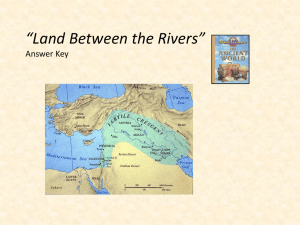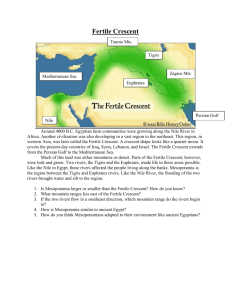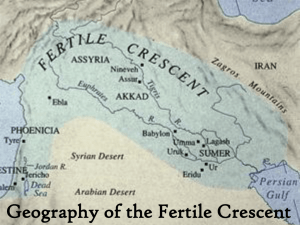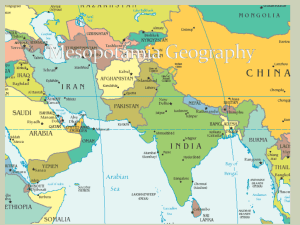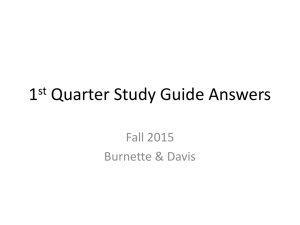Geography of the Fertile Crescent Power Point
advertisement
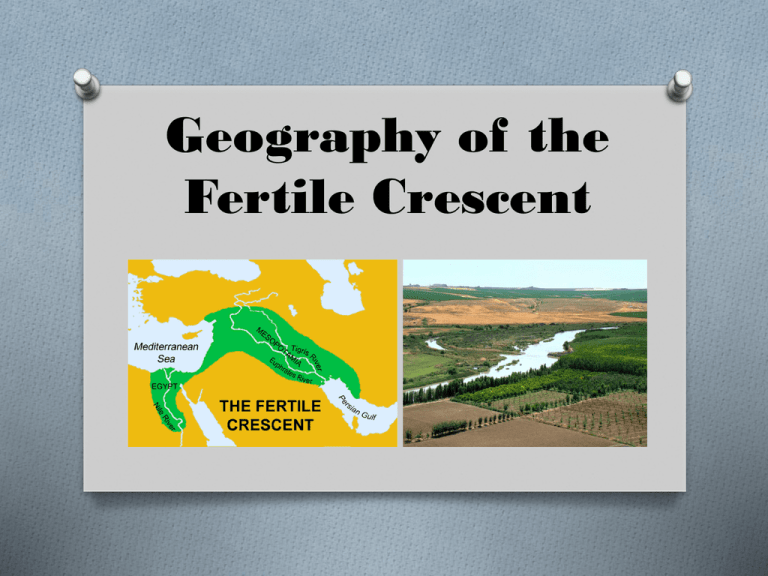
Geography of the Fertile Crescent Essential Question How did geography influence the development of civilization in Southwest Asia? Objective The Valleys of the Tigris and Euphrates rivers were the site of the world’s first civilizations. Main ideas O 1. The Rivers of Southwest Asia supported the growth of civilizations. O 2. New farming techniques led to the growth of cities. Rivers Support the Growth of Civilization Early people settled where plants would grow and crops would grow around rivers The soil around most rivers are rich and fertile because the river will normally flood yearly The land between the Tigris and Euphrates is the Fertile Crescent This area between the Tigris & Euphrates is known as Mesopotamia The 2 parts of Mesopotamia Northern and Southern Mesopotamia Questions O 1. Why was the soil in between the Tigris and Euphrates so fertile giving its name, “Fertile Crescent”? O The Rivers Flood leaving behind fertile Soil. O 2. What is the name of the area between the two rivers called and what does it mean? O Mesopotamia and it means “between 2 rivers” in Greek. The Rise of Civilizations Hunters and Gatherers settled in Mesopotamia 12,000 years ago Silt fertile soil left behind by flooding waters. Great dirt for planting crops and farming 7000 BCE was the first Mesopotamia settlement Grew Wheat & Barley Questions O 3. What type of soil is left behind after the flood waters recede back into the Tigris and Euphrates? O The fertile soil is SILT O 4. What was growing in Mesopotamia around 7000 BCE? O Wheat and Barely Livestock and Fish were other great sources of food With a surplus of food population rises and villages develop The soil in Mesopotamia was very rich and fertile Questions O 5. What were other sources of food in Mesopotamia? O Livestock and Fish O 6. What is a result of a surplus of food? O Population rises and Villages develop But farming wasn’t easy for the early civilization It was due to lack of Rainfall The Tigris and Euphrates relied on rainfall from the Eastern part Flooding occurs when there is too much rainfall And the rivers of the Fertile Crescent do flood killing livestock and destroying crops All this occurs during the “wet season” When it is dry there is an opposite affect but with similar endings When in a drought crops die and so do livestock Questions O 7. Why was Farming difficult in the Fertile Crescent? O Lack of rainfall during the Dry Season and Flooding during the Wet Season. O 8. What is the result during these 2 seasons? O Crops are destroyed and the livestock could be killed What they did was regulate the amount of water and controlled the water flow of the rivers Farmers solved the water problem by the use of Irrigation Irrigation is the artificial watering of Farmland The early farmers of the Fertile Crescent dug out water storage Basins Then they dug Canals, man-made waterways, to water the farmland The water storage basins also stopped flooding water because the built up higher that the river Questions O 9. To regulate the water what did the people of Mesopotamia do to handle the water during the wet and dry seasons? O They dug Storage Basins to hold excess water and Canals to water the farmland. O 10. Define Irrigation? O Irrigation is the artificial watering of farmland Irrigation led to food surplus Farmers irrigated the land for their herds could graze With farming more productive a Division of Labor was created Each person in their society had a specific job to do Questions O 11. Irrigation led to a surplus of food and with farming more productive what did this lead to? O A Division of Labor O 12. What is a Division of Labor? O Each person in the society have a specific job to do. With a surplus of food, a growing population and a division of labor led to a large building projects These projects required specialized workers, managers, and organization To complete these project Mesopotamia needed Rules and Government Around 4000 and 3000 BCE Cities began to develop in Mesopotamia Mesopotamia was based on Agriculture; Cities were trading post and provided leaders with a power base Cities were political, religious, cultural, and economic centers of a civilizations Questions O 13. How might running large projects prepare people for running a government? O Society needs specialized workers, managers, organizations, planning, and rules and this is the birth of government. O 14. Cities began popping up in Mesopotamia and they were trading centers and what else? O They were Political, Religious, Cultural, and Economic centers of civilizations.


